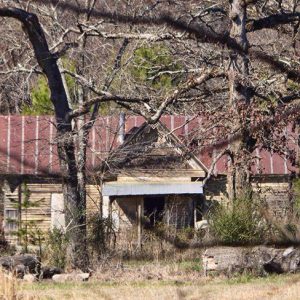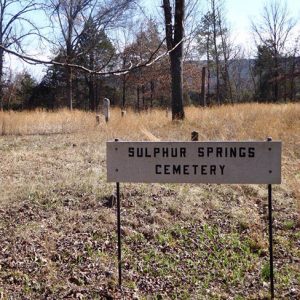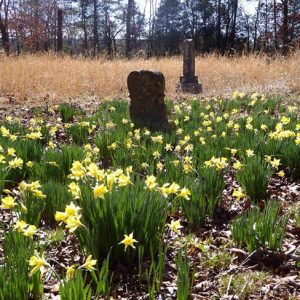calsfoundation@cals.org
Sulphur Springs (Yell County)
In the twenty-first century, Sulphur Springs is nothing more than a few houses and a cemetery. However, in the early to mid-1800s, it was a popular medicinal resort known for its healing waters. The details of its discovery were not recorded, but by the early 1800s, the springs were known as far away as New Orleans, Louisiana, and Boston, Massachusetts, for their purported ability to treat kidney and stomach ailments. The first known advertisement for the springs was published in the May 1, 1841, issue of the Arkansas Gazette, in which proprietor V. T. Rogers stated, “The resort has opened for the season for entertainment for those in search of health and pleasure.” A similar advertisement ran in 1851; the new manager, John R. Harris, claimed that the springs were all under one roof and included “both black and white sulphur water, cool and pleasant to the taste.” He continued by stating that this is “one of the best, cheapest and most picturesque watering places in the known world. Ample accommodations will be found for I have made arrangements for all.”
Because of their proximity to the larger river town of Dardanelle (Yell County), the springs were often advertised in national newspapers as the Dardanelle Sulphur Springs. People would come by rail or boat before making a trek along the dirt roads that led to the springs, often staying for months at a time and sometimes becoming members of the local population of nearby Harkey Valley (Yell County), Chickalah (Yell County), or Dardanelle. Throughout the late 1800s, the community grew considerably and boasted multiple streets and several houses, as well as the Sulphur Springs School and a church. The hotel itself encompassed an entire block. Surviving photos of the large two-story wood structure show several white women, and at least one young girl, sitting in rocking chairs on the front porch. Made entirely of locally cut hand-hewn hardwood from the nearby forest, the hotel had thirty-six rooms and a veranda that ran the length of the structure. Wealthy visitors could enjoy walks by the healing springs and evenings of dancing in the ballroom.
A cemetery was created for the residents and visitors. The first known death was of a young man named Joseph H. Waite. Often referred “Wattie,” he arrived at Sulphur Springs dying from consumption (tuberculosis). According to newspaper reports, after his death, residents wrote home to his family, who sent money for a monument that they inscribed with the words “young, alone, and far from home.” Tuberculosis was not the only illness that brought people to the springs. In 1878, the hotel was filled to capacity, populated by victims of the yellow fever epidemic from Memphis, Tennessee.
It is believed the first hotel was burned by bushwhackers during the Civil War, but a new hotel was started in 1867 and completed in 1872. At one point, a New York–based company owned the building. However, by 1901, the structure and the springs were owned by Judge John F. Choate, a Yell County clerk who raised a family in the area and was buried at Sulphur Springs Cemetery. According to reports, he gave the springs over to the public in an effort to spread the wealth of the healing waters, which had previously been reserved only for visitors with great wealth. According to written reports, members of the Harkey and Tucker families worked at the hotel in the early 1900s, and the last owner of the hotel was Jesse James Tucker.
In 1926, fire claimed the hotel once again while the Tucker family was residing there, operating a boardinghouse and caring for people who were receiving treatment. The hotel was never rebuilt.
In the early 1900s, a man named Bonaparte Rutledge ran a store in Sulphur Springs, which served both communities in the valley. Residents recall the store as a social center, with weddings held on the front porch. As the logging economy died out, the community slowly became a ghost town. Years later, residents claimed they could still smell the sulfur as they walked through the area.
For additional information:
Banks, Wayne. History of Yell County, Arkansas. Van Buren, AR: The Press Argus, 1959.
“Sulphur Springs Cemetery.” National Register of Historic Places nomination form. On file at Arkansas Historic Preservation Program, Little Rock, Arkansas. Online at http://www.arkansaspreservation.com/historic-properties/_search_nomination_popup.aspx?id=2612 (accessed November 9, 2021).
Yell County Historical and Genealogical Association. Yell County Heritage: A History of Yell County, Arkansas. Bedford, TX: Curtis Media, Inc., 1997.
Meredith Martin-Moats
McElroy House: Organization for Folklife, Oral History and Community Action
 Sulphur Springs
Sulphur Springs  Sulphur Springs Cemetery
Sulphur Springs Cemetery  Sulphur Springs Cemetery
Sulphur Springs Cemetery  Sulphur Springs Cemetery
Sulphur Springs Cemetery  Yell County Map
Yell County Map 



Comments
No comments on this entry yet.